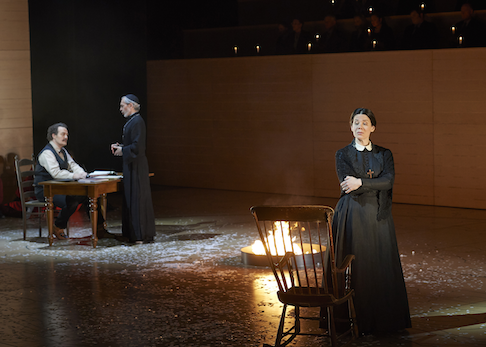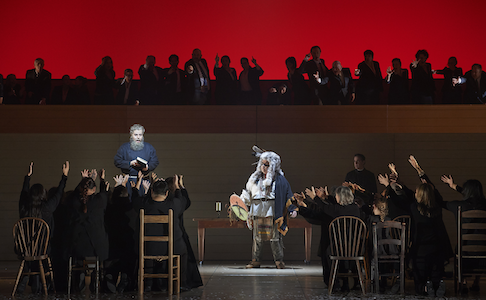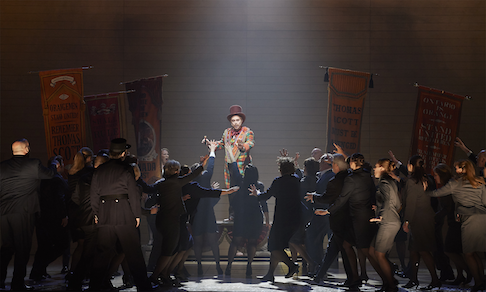![Russell Braun as Louis Riel [Photo by Sophie I'anson]](http://www.operatoday.com/LouisRiel-SI-1272.png)
14 May 2017
Riel Deal in Toronto
With its new production of Harry Somers’ Louis Riel, Canadian Opera Company has covered itself in resplendent glory.
English Touring Opera are delighted to announce a season of lyric monodramas to tour nationally from October to December. The season features music for solo singer and piano by Argento, Britten, Tippett and Shostakovich with a bold and inventive approach to making opera during social distancing.
This tenth of ten Live from London concerts was in fact a recorded live performance from California. It was no less enjoyable for that, and it was also uplifting to learn that this wasn’t in fact the ‘last’ LfL event that we will be able to enjoy, courtesy of VOCES8 and their fellow vocal ensembles (more below …).
Ever since Wigmore Hall announced their superb series of autumn concerts, all streamed live and available free of charge, I’d been looking forward to this song recital by Ian Bostridge and Imogen Cooper.
Although Stile Antico’s programme article for their Live from London recital introduced their selection from the many treasures of the English Renaissance in the context of the theological debates and upheavals of the Tudor and Elizabethan years, their performance was more evocative of private chamber music than of public liturgy.
Evidently, face masks don’t stifle appreciative “Bravo!”s. And, reducing audience numbers doesn’t lower the volume of such acclamations. For, the audience at Wigmore Hall gave soprano Elizabeth Llewellyn and pianist Simon Lepper a greatly deserved warm reception and hearty response following this lunchtime recital of late-Romantic song.
For this week’s Live from London vocal recital we moved from the home of VOCES8, St Anne and St Agnes in the City of London, to Kings Place, where The Sixteen - who have been associate artists at the venue for some time - presented a programme of music and words bound together by the theme of ‘reflection’.
'Such is your divine Disposation that both you excellently understand, and royally entertaine the Exercise of Musicke.’
‘And there was war in heaven: Michael and his angels fought against the dragon; and the dragon fought and his angels, And prevailed not; neither was their place found any more in heaven … that old serpent … Satan, which deceiveth the whole world: he was cast out into the earth, and his angels were cast out with him.’
There was never any doubt that the fifth of the twelve Met Stars Live in Concert broadcasts was going to be a palpably intense and vivid event, as well as a musically stunning and theatrically enervating experience.
‘Love’ was the theme for this Live from London performance by Apollo5. Given the complexity and diversity of that human emotion, and Apollo5’s reputation for versatility and diverse repertoire, ranging from Renaissance choral music to jazz, from contemporary classical works to popular song, it was no surprise that their programme spanned 500 years and several musical styles.
The Academy of St Martin in the Fields have titled their autumn series of eight concerts - which are taking place at 5pm and 7.30pm on two Saturdays each month at their home venue in Trafalgar Square, and being filmed for streaming the following Thursday - ‘re:connect’.
The London Symphony Orchestra opened their Autumn 2020 season with a homage to Oliver Knussen, who died at the age of 66 in July 2018. The programme traced a national musical lineage through the twentieth century, from Britten to Knussen, on to Mark-Anthony Turnage, and entwining the LSO and Rattle too.
With the Live from London digital vocal festival entering the second half of the series, the festival’s host, VOCES8, returned to their home at St Annes and St Agnes in the City of London to present a sequence of ‘Choral Dances’ - vocal music inspired by dance, embracing diverse genres from the Renaissance madrigal to swing jazz.
Just a few unison string wriggles from the opening of Mozart’s overture to Le nozze di Figaro are enough to make any opera-lover perch on the edge of their seat, in excited anticipation of the drama in music to come, so there could be no other curtain-raiser for this Gala Concert at the Royal Opera House, the latest instalment from ‘their House’ to ‘our houses’.
"Before the ending of the day, creator of all things, we pray that, with your accustomed mercy, you may watch over us."
The doors at The Metropolitan Opera will not open to live audiences until 2021 at the earliest, and the likelihood of normal operatic life resuming in cities around the world looks but a distant dream at present. But, while we may not be invited from our homes into the opera house for some time yet, with its free daily screenings of past productions and its pay-per-view Met Stars Live in Concert series, the Met continues to bring opera into our homes.
Music-making at this year’s Grange Festival Opera may have fallen silent in June and July, but the country house and extensive grounds of The Grange provided an ideal setting for a weekend of twelve specially conceived ‘promenade’ performances encompassing music and dance.
There’s a “slide of harmony” and “all the bones leave your body at that moment and you collapse to the floor, it’s so extraordinary.”
“Music for a while, shall all your cares beguile.”
The hum of bees rising from myriad scented blooms; gentle strains of birdsong; the cheerful chatter of picnickers beside a still lake; decorous thwacks of leather on willow; song and music floating through the warm evening air.
![Russell Braun as Louis Riel [Photo by Sophie I'anson]](http://www.operatoday.com/LouisRiel-SI-1272.png)
With its new production of Harry Somers’ Louis Riel, Canadian Opera Company has covered itself in resplendent glory.
Mr. Somers’ challenging three act opera, set to a text by Mavor Moore with the collaboration of Jacques Languirand, charts the fascinating history of Louis David Riel. Now a national hero, Riel helped found the province of Manitoba, and he championed the plight of the Métis indigenous prairie people, seeking to preserve their culture and rights as their homelands came under increasing encroachment by the Canadian government. He led two resistance movements against the political sphere of the first post-Confederation Prime Minister, Sir John A. MacDonald. Riel has attained the revered status of a folk hero.
This operatic treatment is no dusty, linear history lesson, far from it. The angular, pulsating, often jarring score mixes indigenous influences with classical music trends of its time, evoking the sonic world of Stockhausen, Boulez, Penderecki, Foss, and Xenakis. Although I came of age in that era and heard numerous such recordings, I never had the pleasure of experiencing compositions of this school in live performance. With Louis Riel, I made up for lost time.
 (l-r) Russell Braun as Louis Riel, Alain Coulombe as Bishop Taché and Allyson McHardy as Julie Riel [Photo by Michael Cooper]
(l-r) Russell Braun as Louis Riel, Alain Coulombe as Bishop Taché and Allyson McHardy as Julie Riel [Photo by Michael Cooper]
A brilliant aural palette called for a virtuoso orchestra and demanded extremely wide-ranging vocal accomplishments. This was a riveting, engrossing immersion into a model of its genre. Not to say that there aren’t some dramaturgical hiccups in the episodic, presentational structure. But sweeping all before it is a haunting blend of a capella melismatic arias; disorienting percussive effects; searing brass stings; scraping, then soaring strings; flighty woodwind licks; and flawless choral work (Sandra Horst, Chorus Master). Under the assured, inspired baton of Maestro Johannes Debus, this added up to a pretty spectacular evening of first tier, nay, virtuosic music making.
But if there are three key elements to the evening’s success, they are: Russell Braun, Russell Braun, Russell Braun. (Did I mention Russell Braun?) The Canadian baritone is at the top of his game, and commands the stage with a nonpareil traversal of the title role. Tour de force is too puny a phrase to describe the magnitude of Mr. Braun’s achievement. He tears into the punishing role with a De Niro-like intensity and draws on a rock-solid vocal technique that he daringly pushes to its very limit.
This was the sort of “personal best” triumph that, like its subject, merits legendary status; an “I-was-there” performance that I will cherish as a gold standard of operatic excellence for years to come. I am a long time Russell Braun fan, and all his familiar strengths were on ample display: the pointed lyricism, the easy top, the smooth legato, the vibrant tone, the supreme control, the intelligent musicianship. What I could not have anticipated was the reserve of firepower he had at his command, and the heart-stopping emotional commitment that he was able to invest in this towering role assumption. His disjointed, unhinged, anguished Mad Scene that closed Act One was gut-wrenching its impact. The composer often crafts fiendishly high lying phrases for Riel that verge on Sprechstimme shrieks, and Russell negotiated them all with raw power. There is simply no aspect of the complicated vocal line or the complex characterization that eluded him. Unforgettable. Bravissimo divo!
 (l-r) Jean-Philippe Fortier-Lazure as Father André, Everett Morrison as Wandering Spirit and Keith Klassen as Father Moulin [Photo by Michael Cooper]
(l-r) Jean-Philippe Fortier-Lazure as Father André, Everett Morrison as Wandering Spirit and Keith Klassen as Father Moulin [Photo by Michael Cooper]
He was decidedly not alone in his success. Please read the large cast list below, and please know that each and every one of this prodigiously gifted ensemble of Canadian singers made their solo appearances into a true star turn, wondrously sung and fervently acted. Moreover, their efforts congealed into a brilliant, evenly matched musical ensemble that would be envy of any opera company.
It may be odious to single out any of these players, but baritone James Westman was first among equals with his snide, snarling, overbearing, blustering, duplicitous Sir John A. MacDonald (think Donald Trump with high notes). Mr. Westman’s powerful, secure baritone has an easy high extension, and as he effortlessly rode wave after wave of cresting orchestral sound, he seemed more like the world’s next great Heldentenor in making. While most of the arias are given to Riel, his wife Marguerite has an extended solo to open Act III. Singing in Cree, virtually unaccompanied as she cradled their baby, soprano Simone Osborne lavished creamy tone and negotiated seamless register shifts in one of the opera’s longest, most accessible passages. This alluring, poised vocalist surely has a bright future.
Jean-Philipe Fortier-Lazure displayed a ringing tenor as Cartier, and Peter Barrett showed off a burnished baritone as Colonel Garnet Wolseley. The two of them collaborated with Mr. Westman for a gripping, argumentative trio, all tumbling phrases and shifting tonalities. Allyson McHardy brought a dusky, well-schooled mezzo to Riel’s mother Julie, and his sister Sara was well served by Joanna Burt’s agreeable soprano. The two women were especially fine as they urged Riel not to execute Thomas Scott, whose strident non-PC slurs were passionately delivered by Michael Colvin. Mr. Colvin’s characterful singing was exceeded only by the conviction of his acting. Although a slight graininess could creep into his extreme upper register when pressured, veteran bass Alain Coulombe created a sympathetic, tortured Bishop Taché.
Peter Hinton’s inventive staging could hardly have been bettered, as he seized on the concept of ritualizing the story telling. There was much use of religious prayer circles and other symbolic formations, all highly stylized and visually apt. Mr. Hinton had a willing story-telling partner in set designer Michael Gianfrancesco. Mr. Gianfrencesco gave him a minimalist marvel of a playing space, backed by an amphitheater of benches upstage, that could separate, elevate, you name it, and were revealed or enclosed at will by stage width flying dividers. False proscenium towers right and left completed the look, all of it handsomely executed in blond wood.
 (centre) Andrew Love as Dr. Schultz [Photo by Michael Cooper]
(centre) Andrew Love as Dr. Schultz [Photo by Michael Cooper]
This simple design was then filled with all manner of carefully chosen pieces and effects including a roaring fire pit, falling snow, imposing desks, and lots and lots of chairs. The latter were inventively placed, sometimes up-ended, cradled as dead bodies, and even used as “stilts” for actors to tromp around the stage like menacing spiritual forces.
The success of Bonnie Beecher’s sumptuous lighting design cannot be over-praised. With such a sparse scenic realm, her beautifully crafted illumination was critical in delineating the shifting moods and locations. Of especial impact were the bands of color on the upstage cyclorama that were ravishing in well-calculated cross fades from red to azure to fuchsia and all shades in between.
The wide spectrum of Gillian Gallow’s costume design immeasurably helped identify the large cast of disparate characters, and made them readily identifiable to the audience in this sprawling narrative. Ms. Gallow’s skillful choices include garish tartan plaid suits for the Canadian officials. As the indigenous people are gradually absorbed into the general populace, they morph from the bright red garb that made them unique, to all black modern attire indistinguishable from that worn by the chorus. Santee Smith’s haunting ceremonial choreography was an important component in Mr. Hinton’s masterful directorial vision, with lithe Justin Many Fingers moving evocatively as the Buffalo Dancer.
Before I saw this piece I must confess, I did not know who Louis Riel was nor that, some years ago, Harry Somers composed a knotty, disturbing, soaring, compelling, illuminating, moving, unique piece of lyric theatre about a national hero who should have international recognition.
The rapt audience received the production with roaring enthusiasm, knowing they had just participated in an artistic adventure with a seldom-performed work that may not come along again. This profound production of Louis Riel may not send you out of the theatre with a tune in your ear, but it cannot help but have planted a new appreciation of a hero in your heart.
James Sohre
Cast and production information:
The Activist: Cole Alvis; Folk Singer/Elzéar/Lagimodière/Court Clerk/Prison Guard: Jani Lauzon; William McDougal/Judge: Doug MacNaughton; British Soldier/Hudson’s Bay Scout/Father Moulin: Keith Klassen; Ambroise Lépine: Charles Sy; Thomas Scott: Michael Colvin; Joseph Delorme: Bruno Cormier; Janvier Ritchot: Jan Vaculik; Elzéar Goulet: Michael Downie; André Nault: Vanya Abrahams; Baptiste Lépine: Taras Chmil; Louis Riel: Russell Braun; Dr. Schultz: Andrew Love; Charles Mair: Thomas Glenn; O’Donaghue/a Fenian/B.B. Osler/a Prosecutor: Neil Craigshead; Bishop Taché: Alain Coulombe; Sir John A. MacDonald: James Westman; Donald Smith/Gen. Sir Frederick Middleton: Aaron Sheppard; Sir George-Étienne Cartier/Father André: Jean-Philipe Fortier-Lazure; Julie Riel (mother): Allyson McHardy; Sara Riel (sister): Joanna Burt; Colonel Garnet Wolseley: Peter Barrett; Marguerite Riel (wife): Simone Osborne; Gabriel Dumont: Andrew Haji; James Isbister: Clarence Frazer; Poundmaker: Billy Merasty; Louis Schmidt/Dr. François Roy: Bruno Roy; Wandering Spirit/War Chief of the Crees: Everett Morrison; F.X. Lemieux (lawyer): Dion Mazerolle; Buffalo Dancer: Justin Many Fingers; Conductor: Johannes Debus; Director: Peter Hinton; Set Design: Michael Gianfrancesco; Costume Design: Gillian Gallow; Lighting Design: Bonnie Beecher; Choreographer: Santee Smith; Chorus Master: Sandra Horst